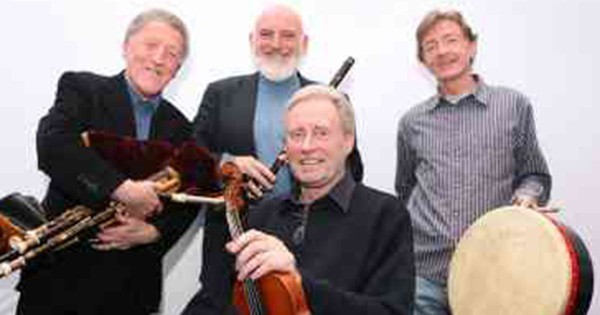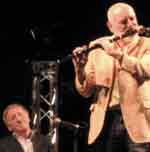The Chieftains are one of the most remarkable bands to ever come out of Ireland.

Changing Musicians
Grammy Awards
LandMark Performances
Film Soundtracks
Singing with the Stars
The Chieftains videos
They have won six Grammy awards and been nominated 18 times.
They almost single-handedly revived Irish instrumental music while still holding down day jobs and ironically perhaps, the more quintessentially Irish their music became, the more it appealed to a worldwide audience.
They won numerous awards, sold millions of records, became feted all over America and Europe, and were even invited by the Chinese to perform a concert on the Great Wall of China. They also gave Michael Flatley of Riverdance fame his first break.
Collaborating with rock stars to perform Irish songs

The Chieftains have regularly caught the attention of stars from other musical genres who have been keen to perform with them.
Collaborations with Irish singers like Van Morrison and Sinead O’Connor might be expected.
However, many were taken by surprise when The Chieftains started recording with musicians like The Rolling Stones, Sting, Roger Daltrey from The Who, Mark Knopfler and numerous others.
They were also invited to perform the music for Hollywood films. It was all a long way from their humble beginnings back in Ireland.
International stars while working for the Post Office
Another remarkable aspect of The Chieftains’ story is that for the first 12 years of their careers, they only performed in their spare time and held on to their day jobs. Some of the band worked for the Department of Post and Telegraph in Ireland.
That seems surprising now but we have to remember that they started out in the 1960s in Ireland when work was hard to come by so if you had a job you tended to guard it carefully.
Also, there wasn’t much demand for their kind of music in those early days. They had to create the market themselves.
The Chieftains voted Band of the Year
Paddy Moloney says his mother didn’t consider music to be a full-time occupation.
It was something only to be pursued in your spare time.
Even when The Chieftains had become world famous she would joke that Paddy didn’t have a proper job.
Everything changed in 1975 when they were voted Band of the Year by the British music magazine Melody Maker – fighting off competition from the likes of Led Zeppelin and The Rolling Stones.
They also gained added confidence around that time when they played to an audience of 25,000 at the Cambridge Folk Music Festival in England and were called back to perform three encores.
Given their rising popularity and critical acclaim, they finally decided to take the plunge and go professional.
The early days of The Chieftains
That decision had been nearly 15 years in the making. The band had begun way back in 1962 when founding member and driving force Paddy Moloney wanted to record some of his instrumental arrangements of Irish tunes.
Paddy played the uilleann pipes and he teamed up with Martin Fay on fiddle, Sean Potts on tin whistle and Michael Tubridy on flute.
The musicians already knew each other well having played together in Ceoltoiri Cualann, the Irish folk orchestra set up by Sean O’Riada.
Death of a Chieftain, birth of a band
The budding new group got their name from a director of Claddagh Records, John Montague who had written a poem called Death of a Chieftain.
He suggested The Chieftains as a name and it stuck. It also became the title of the album the band were about to record for the Claddagh record label.
The band’s first album, The Chieftains, was released in 1963.
Critically acclaimed but not a best seller
The album featured instrumentals and although well received, it was not very successful commercially, certainly not successful enough for the band to turn professional.
In those early years the Irish folk scene was dominated by bands like The Dubliners and The Clancy Brothers who, although they included a few instrumentals in their sets, concentrated largely on songs. The Chieftains would have to wait a while longer.
In the meantime, Paddy Moloney helped to run Claddagh Records.
Long wait for Chieftains 2
The band held on to their day jobs and played several concerts over the next five years but it wasn’t until 1969 that they next went into a recording studio to make a new album.
Chieftains 2 was again well received and by now the band were developing a small but devoted following.
Moloney described how those first two albums started to attract the more avant garde people on the London scene, as well as hippies and young people who considered themselves into Flower Power.
Rubbing shoulders with the Entertainment Elite
The Chieftains played their first concert in the United States in 1972 at the Irish Arts Theater in New York. They followed that up with tours of the US in 1973 and 1974, even though they were still only semi-professional and had to beg and cajole their bosses for time off work.
Meanwhile, the band were attracting the attention of other musicians and leading lights in the film world. Peter Sellers became a fan after meeting Paddy Moloney in 1966 at the house of the late Brian Jones, the Rolling Stones guitarist.
Sellers went on to write the sleeve notes on Chieftains 4. The Rolling Stones and Marianne Faithfull later went on to record with The Chieftains.
Chieftains 3 and 4, and the arrival of the harp
Chieftains 3 was released in 1971 but by the time the band were ready to record another album in 1973, Moloney wanted to add a new dimension in the form a harp.
The Irish harpist Derek Bell was a member of the BBC orchestra in Belfast and had played with The Chieftains several times. He joined them on a more permanent basis in time for the recording of Chieftains 4, although he still kept performing with BBC.
A sell-out concert at the Albert Hall
After turning fully professional in 1975, the band played a sell-out concert at the Albert Hall in London. It signalled their arrival as a full-time band to be reckoned with.
Chieftains albums 5, 6 and 7 soon followed to continuing critical acclaim and growing commercial success.
As the end of the 1970s approached, there were to be changes to the line-up on the band. Sean Potts and Michael Tubridy left and Matt Molloy, formerly with The Bothy Band and Planxty arrived, to play flute.
Breakthrough appearance on American television
In 1986, The Chieftains appeared on The Today Show in the United States.
It was another major breakthrough for them as it brought them to the attention of millions of viewers and helped to establish them in America.
The band were now enjoying the kind of commercial success their talents and their hard worked deserved.
Chieftains legacy is revival of Irish instrumental music
Before The Chieftains, most people’s idea of Irish traditional music was the kind of material being performed by bands like The Dubliners and The Clancy Brothers.
Those bands were brilliant, of course, but their repertoires were made up mainly of songs. In the early sixties, instrumental arrangements of Irish music had all but died out.
The Chieftains changed all that. They single-handedly created a taste and a market for high quality instrumental music. In the process, they recorded approximately 50 albums, including six Grammy winners, picked up an Oscar or two plus numerous other awards and played at some of the major venues all over the world.
Not bad for a bunch of lads who started out with nothing and had to wait 12 years before they could turn professional.
The Chieftains roll call of musicians
The Chieftains Grammy Awards
Landmark Performances by The Chieftains
The Chieftains music used on film soundtracks
The Chieftains performing with other music stars
Music videos from the legendary Irish band The Chieftains